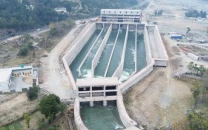Pakistan’s energy security
Pakistan spends $1 billion in oil imports per 1,000 MW, which is not cost-effective. Nuclear energy can reduce burden.

The writer is a visiting faculty member at the School of Politics & International Relations, Quaid-e-Azam University
Pakistan has an installed electricity generation capacity of 22,797MW. The average demand is 17,000MW and the shortfall is between 4,000 and 5,000MW. Oil (35.2 per cent), hydel (29.9 per cent), gas (29 per cent), and nuclear and imported (5.8 per cent) are the principal sources. In the next 10 years, peak electricity demand is expected to rise by four to five per cent, which is roughly 1,500MW. This dismal forecast is due to a lopsided energy mix, diminishing indigenous fuel reserves, increasing circular debt and transmission hold-ups. Pakistan has almost exhausted its gas reserves. Imported oil’s price hikes affect the budget and its constant supply cannot be guaranteed. Pakistan has the potential to meet these energy challenges through hydel power but there are political and environmental issues in building dams. Rationality demands reducing reliance on oil and going for alternatives. The development of alternatives does not happen overnight. Pakistan will have to rely on imported fuels for the interim period at a huge cost. LNG is difficult to import, using coal has environmental issues, using shale gas also has environmental issues attached with it, and wind power has transmission network challenges.
Nuclear energy seems the best option for Pakistan because the cost of oil-based generation, other alternatives and their indigenisation is pretty high. The nuclear reactors that are being constructed in Karachi are called Advance China Pressurised–1000 reactors and are the latest technology over which China has complete intellectual property rights. These reactors are often confused with Chinese CPR-1000 design that is an advanced version of French M-310 technology. China also has complete intellectual property rights for that technology. It's a global norm that nuclear reactors are released for sale only after passing through several developmental stages. Like any other industry, there is always a first buyer and here Pakistan is no exception. Besides this, the International Atomic Energy Agency’s (IAEA) watchful eyes do not compromise on design and safeguards standards. International practices show that the close proximity of reactors to Karachi should not be of great concern. Sixty-five out of 104 reactors in the US are within a 10-50 miles vicinity of densely populated states like New York. Despite the Three Mile Island nuclear disaster of 1979, those ageing American reactors pose no safety concerns. It has been internationally accepted that NPPs are more environment-friendly compared with fossil fuel-based plants. Industrialisation has its hazards — even dams have environmental issues — but the fact remains that NPPs provide clean and uninterrupted power supply at a competitive cost.
The two reactors have a reported US$9.1 billion capital cost, which is expensive indeed. However, these will be cheaper in the long-term due to affordable power generation cost. China is not only providing the NPP technology; unlike other suppliers, it is reportedly offering 82 per cent of the financing as well. The current energy basket rate for electricity generation in Pakistan is around Rs12.3/KWHr, which is calculated by taking a mean of the cost of electricity from all sources. In that sense, NPPs with a levelised cost of electricity in the range of Rs5-8/KWHr is worthwhile.
The Fukushima nuclear disaster in 2011 cast a dark spell on the use of nuclear energy — but for a short while. Japan had abandoned its reliance on nuclear energy but has recently reverted its stance. The Fukushima disaster was not due to technical failures or inadequate safety features. An unparalleled tsunami completely swamped the back-up power for cooling the plants. China has offered cutting edge technology with the latest safety and design features. The Pakistan Nuclear Regulatory Authority and the IAEA remain actively involved in selecting the sites for the new reactors and a thorough survey has been done in this regard.
There is a misperception that China has violated its obligations of the Nuclear Suppliers Group (NSG) in offering these reactors to Pakistan. It is worth noting that China is, in fact, meeting international legal obligations of a nuclear agreement that it made with Pakistan in 1986, which was before it joined the NSG in 2004. This, notwithstanding, these reactors, will be under IAEA safeguards and will produce electricity, not bombs. The criticism about these reactors is political in context. This peaceful nuclear cooperation can be considered to be an effort on Pakistan’s part to counterbalance the Indo-US nuclear deal and New Delhi’s efforts to join the NSG, which is a nuclear export control cartel. The US offered the nuclear deal to India for economic returns and also because of New Delhi’s so-called potential as a counterweight to Beijing. Pakistan’s agreement with China predates the Indo-US nuclear deal and Islamabad has no extra-regional ambitions. The Pakistan-China deal does not violate international norms but the Indo-US nuclear deal does. The US bent its domestic laws and pressurised NSG members to bend theirs for potential trade with India.
Nuclear energy is a quintessential part of Pakistan’s energy mix. Scarce hydrocarbon sources pose political, economic and environmental issues. Nuclear energy is a safe and viable alternative. Pakistan spends $1 billion in oil imports per 1,000 MW, which is not cost-effective. Nuclear energy can reduce that burden. China has shared the safest and the most cutting edge technology that will alleviate the burden on the Pakistani economy and enhance energy security — no one else has made us such an offer. Nuclear energy is an effective solution that will produce uninterrupted electricity at an affordable price. Let’s hope we overcome the simple challenge of switching on a light bulb.
Published in The Express Tribune, January 7th, 2014.
Like Opinion & Editorial on Facebook, follow @ETOpEd on Twitter to receive all updates on all our daily pieces.













COMMENTS
Comments are moderated and generally will be posted if they are on-topic and not abusive.
For more information, please see our Comments FAQ